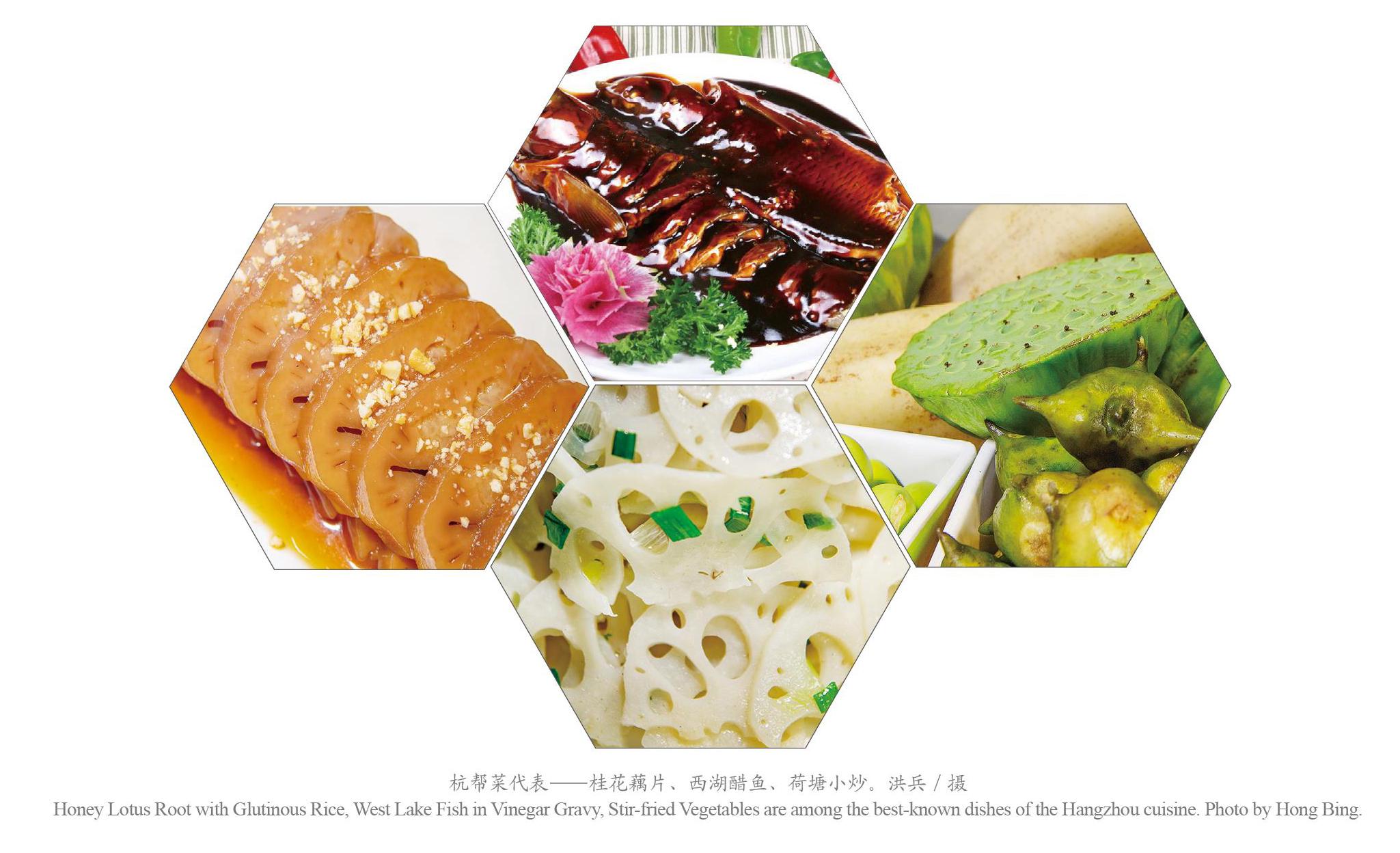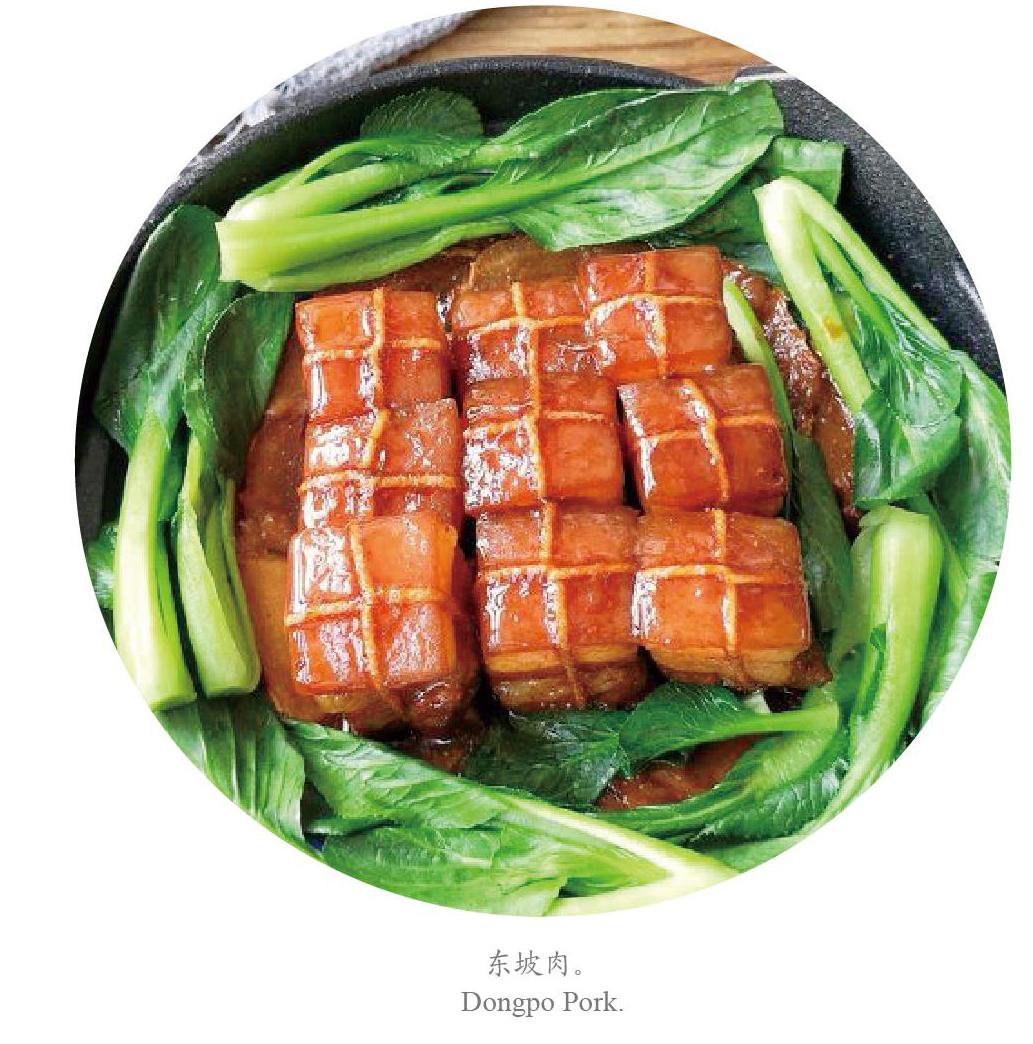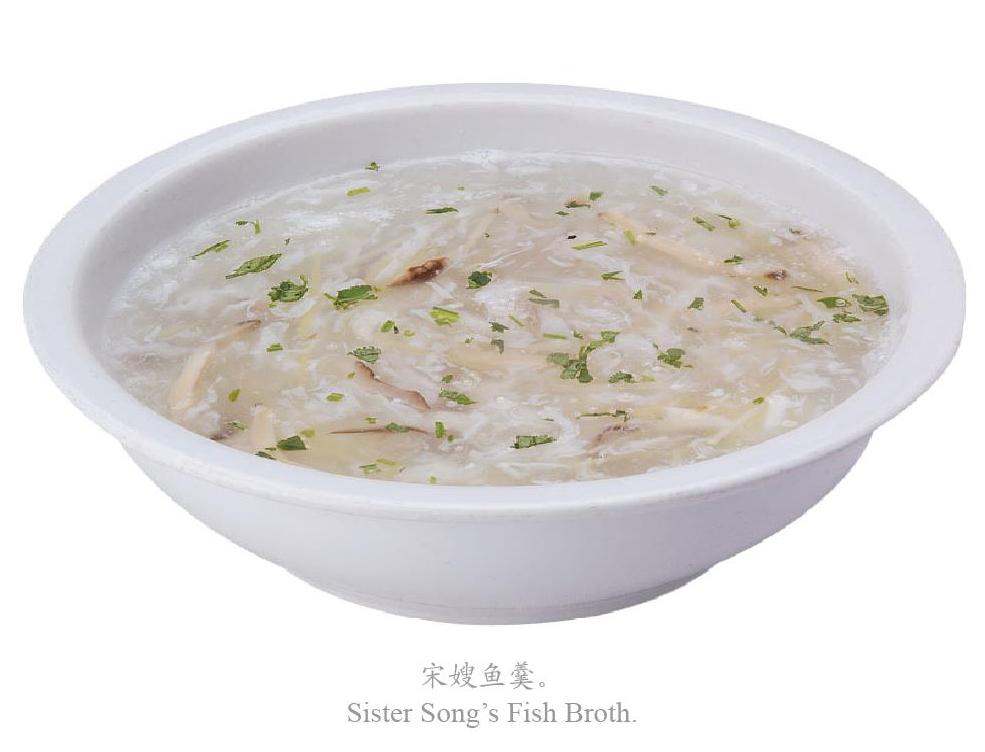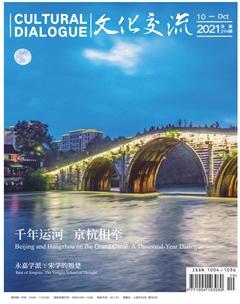杭帮菜的故事
潘江涛



“浙菜”由杭帮、甬菜、瓯馐和绍味构成,属中国八大菜系之一,久负盛名。
杭帮,乃“杭帮菜”之简称,是一种“南北合”的菜肴,擅长煮、炖、焖、煨,重原汁原汤。金华人相对口重,却不排斥清新、淡雅、细腻的杭帮菜,甚至还有“百吃不厌”之感。
一
江南忆,忆江南,一定不会忘记老底子的杭帮菜。
所谓的老底子,不妨从良渚文化遗址中寻找:五千多年前,杭州人就已懂得“饭稻羹鱼”——用稻米做饭,用鱼鲜做羹,专家认为,此乃杭帮菜的雏形。
一方水土养一方人。随着时代发展,杭帮菜博采众长,渐渐从“浙菜”中脱颖而出,执“浙菜”之牛耳,不能不归功于大运河的开凿和宋室的南渡。
隋代钱塘升郡,大运河开通,南方财富汇聚于杭,北上中原。临安(今杭州)由此成为融经济、文化、政治、交通于一体的南北大动脉终端,汇集了各地的饮食风情。譬如,京帮擅长制作难度较大的“硬菜”——熊掌、燕窝、鱼翅、海参……,这些山珍海味强调吊汤、重火劲、重入味,菜品味醇、香厚。有了大运河的便利,杭州的众多酒家、餐馆引进了不少京帮菜馆的优秀厨师,他们各展所长,杭帮菜中自然少不了清扒鱼翅、稀卤海参、蟹黄鱼肚等等高档京帮菜。而且,厨师们在菜肴风味上略加改进,更迎合南人的胃口。
宋朝君臣原是居住在黄河流域的北方人,传统食物是面條和羊肉。当年,他们因“靖康之难”被迫迁都于杭州(临安)后,把饮食习惯也带到了江南。而都城临安既有物产丰博之利,又有碧海青山之秀,当地人又善于博采众长,终于造就南北杂糅的杭帮菜完整体系。到了清朝,杭帮菜达到更高水平,乾隆西湖行宫御膳食谱保存至今,仍不失为杭帮菜的精美缩影。
所以说,杭州的美,不仅美在“东南形胜”,也美在“自古繁华”;不仅美在“春来江水绿如蓝”,也美在江河之外的“商贾云集,酒肆林立”。如果说灵山秀水是来自大自然的丰厚馈赠,那么杭帮菜便是点缀于山水间的饰物,南北辉映、相得益彰。
有评论家说,中华民族大大小小的融合数不胜数,大多湮没在历史的长河里,但杭帮菜历时八百年 ,既能高度融合又能清楚分辨南北特色,不得不说是个传奇。
二
一款好的菜肴,不外乎色、香、味、形俱全。杭帮菜之所以是个“传奇”,除了看色闻香品味之外,更能发挥想象,体悟意境。
意境,景中有情,情中有景,情景交融,是中华民族在长期艺术实践中形成的一种审美意趣。杭帮菜既注重色香味,更讲究意境美,以满足消费者精神上的快感和对现实生活的体味。《梦粱录》说:“杭城风俗,凡百货卖饮食之人……盘食器皿,新洁精巧,以炫耀入耳目……”
美馔美器,美美与共。只要稍微留意,即能发现杭州的大厨善于运用刀法、配色、装盘等烹饪技艺和美学原理,把精与美、强与巧有机结合,在不经意中呈现出一种含蓄之美。譬如,传统名菜薄片火腿,片片厚薄均等、整齐划一,每片红白相间,造型犹如江南水乡的拱桥,犹如一幅超脱绝俗的水彩画。
“一菜一典”,又是杭帮菜的另一文化特色。像东坡肉的轶闻、叫化鸡的来历、西湖醋鱼的传说、龙井虾仁的联想、宋嫂鱼羹的佳话以及莼鲈之思的寓意,无不诗情画意,趣味盎然。
不独如此,念一念那些传统名菜名点,也都是滴溜溜的顺口——龙井虾仁、叫花童鸡、蜜汁火方、清蒸鲥鱼、火蒙鞭笋、荷叶粉蒸肉、西湖莼菜汤、咸件儿、片儿川、猫耳朵等,光听听菜名,就仿佛置身烟波浩渺的西子湖畔,临湖沐风,推杯换盏,谈笑风生。
“赏西湖景、吃杭帮菜”,是杭州作为国际旅游城市的标志性主题。从十年前即2011年11月10日开始,杭州市就开启了两场有关“杭帮菜”的盛大赛事。前一场聚焦的,是已经在岁月的淘漉中沉淀了口碑和人气的精品菜肴;后一场关注的,则是老百姓家席的美味和创意。
那时候,我已着手金华风物的挖掘与整理,虽说注意到了这两场盛大赛事,却苦于公务缠身,无缘现场观摩。好在我记下了《杭州日报》记者柯静的精彩描述:
当杭菜厨师以一手堪比掌上舞蹈的精湛烹饪技术,惊艳全场的时候;当杭州美食作为一张金名片,走向世界、享誉海外,并为宣传杭州立下汗马功劳的时候;当中外游客在“美食天堂”,对立足传统又不断推陈出新的杭帮菜赞不绝口的时候;当杭菜品牌国际化发展战略,一点点变为现实,呈现让人惊叹的杭帮菜效应的时候……苏东坡的那句“天下酒宴之盛,未有如杭城也”,由此得到了最好的诠释。
食,不分贵贱。吃前有期待、吃后有回味的东西就可以称之为美食。在杭州,城市的繁华,西湖的静美,文化的延续,最后都汇集到了一道道菜肴中。
2016年9月,杭州承办高规格、高难度的G20峰会,各国首脑面对可口的杭帮菜,既饱口福,又享眼福。
三
一个城市、一个街巷以及一户人家厨房的味道非常执着,是轻易改变不了的。然而,你千万不要以为,上得了国宴的“硬菜”只有楼外楼、知味观、丰聚园、山外山等名店名馆才有。
杭州人爱吃懂吃,也会做吃。只要是家庭聚会,或者有朋自远方来,他们都会上有名馆子、街头小店点上一桌特色菜,或者是卷起袖子、围上围裙,炒几个杭州的家常菜,众人一起尽情享用老底子的杭州味道。
“龙井虾仁”是20世纪二十年代推出的新菜,大小餐馆都能做。这道菜用龙井茶的嫩芽搭配虾仁烹制而成,原料简简单单,虾仁与几叶绿茶之外再无他物,可谓简单到了极致;调料也很少,三两种而已。虾仁白嫩晶莹,龙井翠绿欲滴,盛在洁白的餐盘里,自是一幅十分清雅的文人小品画。记得1972年美国总统尼克松访华时,周恩来总理在杭州设宴招待,菜单上就有此菜。
美食的好坏,和店铺的名气并没有完全对等的关系。无人敢说,小店铺就做不出好菜肴。一些真正的美食,往往需要我们带着发现的目光去寻找。譬如,当年那只香透了的老头儿油爆虾如今已经做成了杭州本地知名的连锁品牌。
老头儿,是一些老杭州人对老爸的称呼;油爆虾,则是杭州土著最爱的下酒菜。谁能想到,当“老头儿”和“油爆虾”撮合到了一块儿,居然成就了一家极为火爆的餐馆。
退职离岗前,杭州虽说没有少去,却一直无缘得见那“火爆”场景。不过,读一读李郁葱、王珍的描述,你就能感知什么叫“小店不小”。
“杭州人爱吃,这造就了杭州美食江湖的一些独特景象,像现在已经很有名的开了很多连锁店的一家油爆虾店,当年在一个深深巷子里开第一家的时候,那个老板极牛,瘸着个腿,客人点菜多了他要生气,说够了,然后给你划掉几个……”
这是李郁葱的话语,而王珍说得更直白:
“几回试吃之后,感觉老头儿绝不仅仅是传说,他也是个真实。”“每晚8时30分,时间一到即刻打烊,不管还有多少嗷嗷待哺的食客在排队。店家很牛:‘钞票是赚不光的。日复一日,天天是这样的长队。”
前不久去杭州访友,在街头小店见着有一只简淡素静,如同素斋的“荷塘小炒”,欢喜得不行。
那家小店很偏僻,虽说少了油爆虾店的热闹,但莲子、秋菱和藕带3种食材,均来自乡间荷塘。下锅清炒,只用极少量的素油,大火炝了十几秒。上得桌来,清清白白,犹如宋人小品,自带远山野畈的清气,更有陶潜布衣归耕南山的苍古怡然。
还有,韭芽鸡丝、调羹步鱼、酱爆螺蛳、饭焐茄子、干菜鸭子……杭幫菜吃不厌,也说不尽。但每临酒宴散席,肚子为何还有“空落落”之感?
对了,少了“片儿川”。不妨再叫一大盆,大家分分,每人一小碗,这才温心暖胃。
片儿川,是杭州餐馆的头牌主食。面的底料是咸菜肉丝和笋片,次次现炒,而杭州人喜欢的倒笃菜是一切“鲜”美之源。底料炒好后,加三勺清水,倒笃菜与嫩笋爆炒的鲜就开始在锅里窜开,汤水一滚,三两碱面下锅,也是要滚几秒才能捞起,为的就是让面吃透那个“鲜”。一碗一烧,腌了一个月的倒笃菜,天地间自然发酵之美都收凝在这一碗中。何况,杭州人还喜欢在滚面过程中加点盐或者酱油,这就是他们家常的最爱。“饱”和“鲜”俱备,就是一碗好面。
片儿川,是否属于杭帮菜系列,我不曾探究。但我知晓,杭州江洋畈有座杭帮菜博物馆,那里展出的菜品丰富,体系齐全,光菜名就有多种版本。
手头有一组数据是官方发布的:1956年评定杭州名菜36道,2000年评了48道,2006年评了108道。而民间流传的菜品少说也有500道,每一道都飘逸着“妈妈的味道”。
The Story of Hangzhou Cuisine
By Pan Jiangtao
Zhejiang cuisine is famously known as one of the eight traditional Chinese cuisines, featuring Hangzhou, Ningbo, Shaoxing and Wenzhou flavors. And among the four flavors, Hangzhou flavor is of a fusion taste, combing the flavors both from the northern and southern parts of China. For Hangzhou cuisine, the cooking techniques of boiling, stewing, simmering are frequently used, and the ingredients and their liquids tend to be seasoned lightly.
When thinking about Jiangnan (south of the Yangtze River), people always think about traditional Hangzhou dishes.
The traditions of Hangzhou dishes could be traced back to the Liangzhu Culture. As early as over 5,000 years ago, Hangzhou locals had already used paddies to cook rice and fish meat to make soup, which, according to experts, is the original form of Hangzhou dishes.
The fact that Hangzhou cuisine stands out from Zhejiang cuisine is attributed to the opening of the Grand Canal and the southward movement of the Song dynasty (960-1279).
During the Sui dynasty (581-618), money from southern China flew into Hangzhou, a hub of economy, culture, politics, transportation, as well as food. Many local restaurants hired excellent Beijing chefs, who introduced luxurious Beijing dishes such as sharks fin, sea cucumbers, crab and fish maw into the Hangzhou cuisine after slightly changing the flavors for the southern taste buds.
The ruling class of Song dynasty were originally northerners living in the Yellow River Basin, habitually living on noodles and mutton. When they were forced to move to Hangzhou (then known as Linan), they also brought along their eating habits. Gradually a complete set of Hangzhou cuisine mixing northern and southern flavors was created. In the Qing dynasty (1616-1911), Hangzhou cuisine developed to a higher level, evidence of which could be found in the well-preserved recipes of the imperial residence at the West Lake for Emperor Qianlong (1711-1799).
If Hangzhous beautiful landscape is natures gift, then the local cuisine, an 800-year legend, certainly made the place more attractive.
A good dish is always expected to excel in color, aroma, taste, and shape. Hangzhou cuisine has more to offer: it touches peoples heart and gives them a space for imagination, a spiritual pleasure and a taste of real life.
Behind the Hangzhou cuisine are chefs who are adept at using culinary techniques and aesthetic principles. Their excellent skills with knife, color matching and plating adds some subtle beauty to the dishes.
Whats behind the Hangzhou cuisine are poetic legends, too. It is said that for every Hangzhou dish there is a story to make the dish tastier and more interesting. And the names of the traditional Hangzhou dishes are also easy and smooth to read out loud.
Hangzhou as an international tourist city has been attracting visitors and “enjoy the West Lake and Hangzhou cuisine”. On November 10, 2011, Hangzhou started to host two grand events celebrating its local cuisine. The first one focused on the exquisite fine dishes that have already been popular, while the second one focused on the home-cooked food that are delicious and creative.
In September 2016, Hangzhou hosted the G20 Summit, where heads of state were impressed by the delicious Hangzhou cuisine.
The flavor of a city, a street and a family cannot be easily changed. Apart from the famous restaurants such as Louwailou, Zhiweiguan and Fengjuyuan which serve abundant meat dishes qualified for a national banquet, there also are eateries or street vendors where one can taste the real Hangzhou.
“Longjing Shrimp” is a new dish introduced in the 1920s, widely served in restaurants, large and small. Always on a white plate, this elegant-looking dish only uses fresh shrimps which are white and crystal, and a few emerald green tea leaves, with very little seasoning. No wonder this dish was put on the menu for a banquet hosted by Premier Zhou Enlai in Hangzhou to entertain U.S. President Richard Nixon, who visited China in 1972.
However, it does not necessarily take a large restaurant to make really good food. Small eateries can also provide customers with hearty and delicious dishes, and the authentic Old Mans Oil-Popped Shrimp is one of them. By combining the name “old man” (“dad” in Hangzhou dialect), and oil popping shrimp, a local favorite, it has turned into an unexpectedly popular restaurant chain that is always packed. And there are quiet, relatively isolated, thus less-packed eating places as well, which are inviting in their own way.
When it comes to warm dishes that are close to the heart of Hangzhou locals, Pian Er Chuan, noodles with preserved vegetables, sliced pork and bamboo shoots in soup, are certainly not to be missed.
It is the top staple served by many Hangzhou restaurants. The base of the noodles is shredded pork stir-fried with bamboo shoots, and authentic preserved vegetable is the umami element of this dish. When the base is done and ready to use, three spoons of water will be added to bring out the freshness of the stir-fried shredded pork and bamboo shoots. Next, when the soup boils, some alkaline noodles will then be put into the pot to cook for a few seconds before taking them out into a bowl. This is to maximize the “freshness” of the noodles. Some Hangzhou locals make Pian Er Chuan at home, and they like to add a small amount of salt or soy sauce in the middle of the cooking, to enrich the flavor in a homely style.
In Hangzhou, there is a Hangzhou Cuisine Museum where a complete system of Hangzhou local dishes can be found. Here are some officially released data: in 1956, 36 Hangzhou dishes were selected into the famous Hangzhou Cuisine system, in 2000, the number grew to 48, and in 2006,108. And there are at least 500 dishes widely and dearly loved by Hangzhou folks, because these dishes remind them of their “mums cooking”.
Different places will feature different foods and different flavors. It is always important to inherit and innovate the local dishes, and let the food culture of different places flourish, for it is the differences that have made each place unique in their own way.

